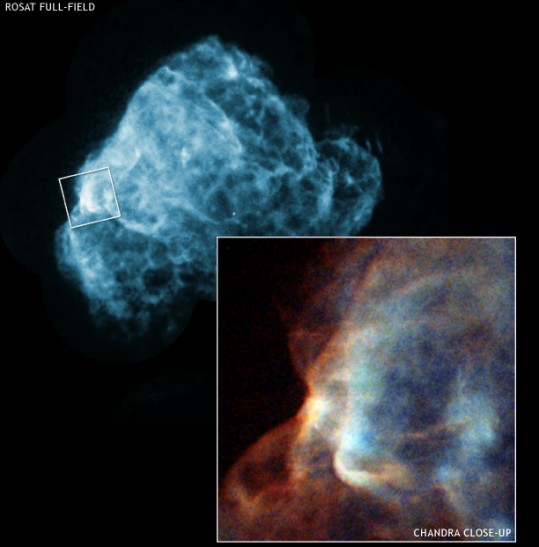
|
Explanation: A massive star ends life as a supernova, blasting its outer layers back to interstellar space. The spectacular death explosion is initiated by the collapse of what has become an impossibly dense stellar core. Pictured is the expanding supernova remnant Puppis A - one of the brightest sources in the x-ray sky. Now seen to be about 10 light-years in diameter, light from the initial stellar explosion first reached Earth a few thousand years ago. Recorded by the Chandra Observatory's x-ray cameras, the inset view shows striking details of the strong shock wave disrupting an interstellar cloud as the shock sweeps through preexisting material. The larger field ROSAT image also captures a of pinpoint source of x-rays near the remnant's center. The source is a young neutron star, the remnant of the collapsed stellar core kicked out by the explosion and moving away at about 1,000 kilometers per second.
|
January February March April May June July August September October November December |
| ||||||||||||||||||||||||||||||||||||||||||||||||
NASA Web Site Statements, Warnings, and Disclaimers
NASA Official: Jay Norris. Specific rights apply.
A service of: LHEA at NASA / GSFC
& Michigan Tech. U.
Based on Astronomy Picture
Of the Day
Publications with keywords: supernova - supernova remnant - shock wave
Publications with words: supernova - supernova remnant - shock wave
See also:
- APOD: 2025 October 1 Á NGC 6960: The Witchs Broom Nebula
- APOD: 2025 July 31 Á Supernova 2025rbs in NGC 7331
- APOD: 2025 June 9 Á Between Scylla and Charybdis: A Double Cosmic Discovery
- Supernova Remnant Cassiopeia A
- APOD: 2025 January 8 Á Supernova Remnants Big and Small
- APOD: 2024 September 18 Á The Mermaid Nebula Supernova Remnant
- APOD: 2024 April 16 Á Filaments of the Vela Supernova Remnant
